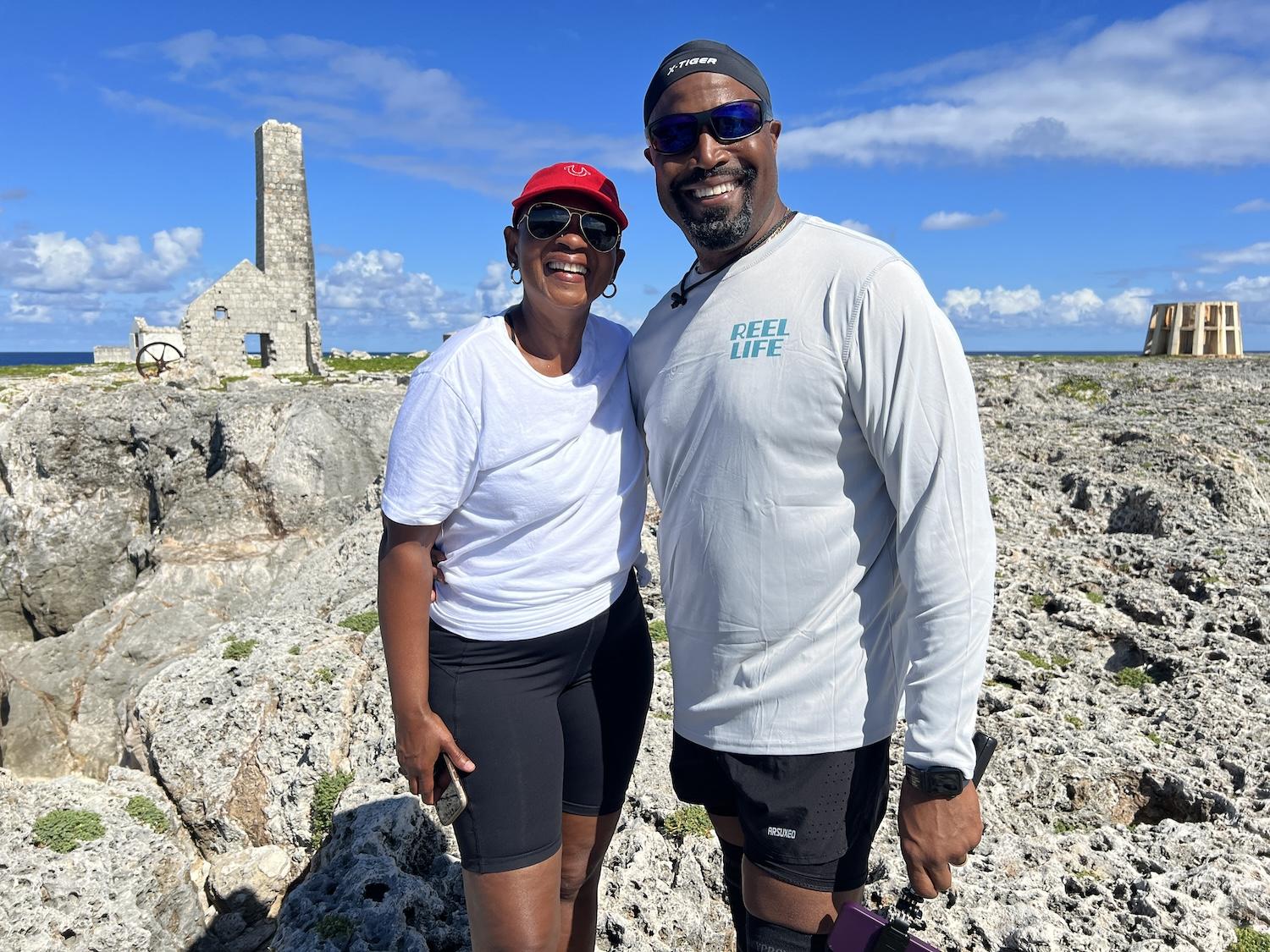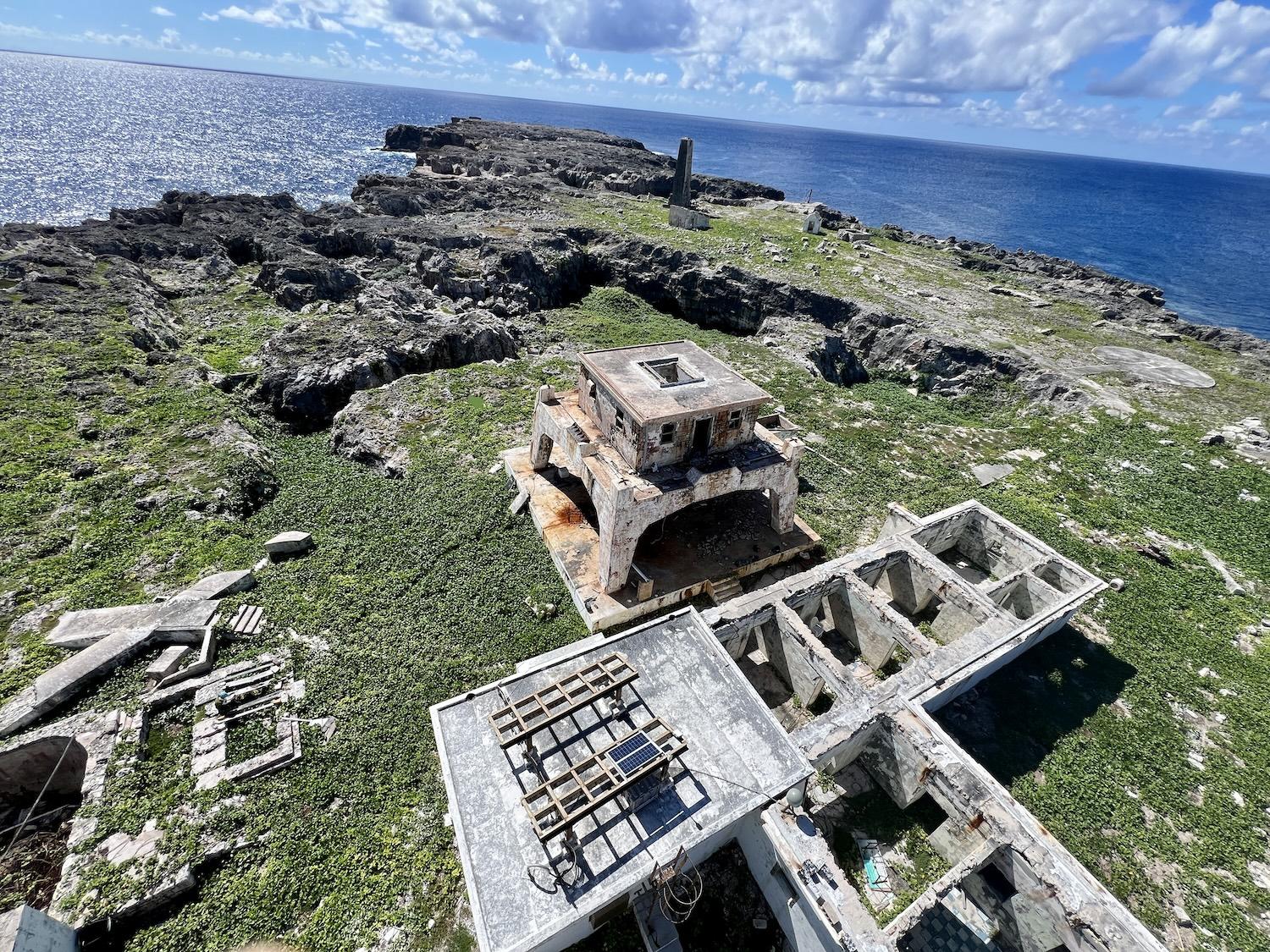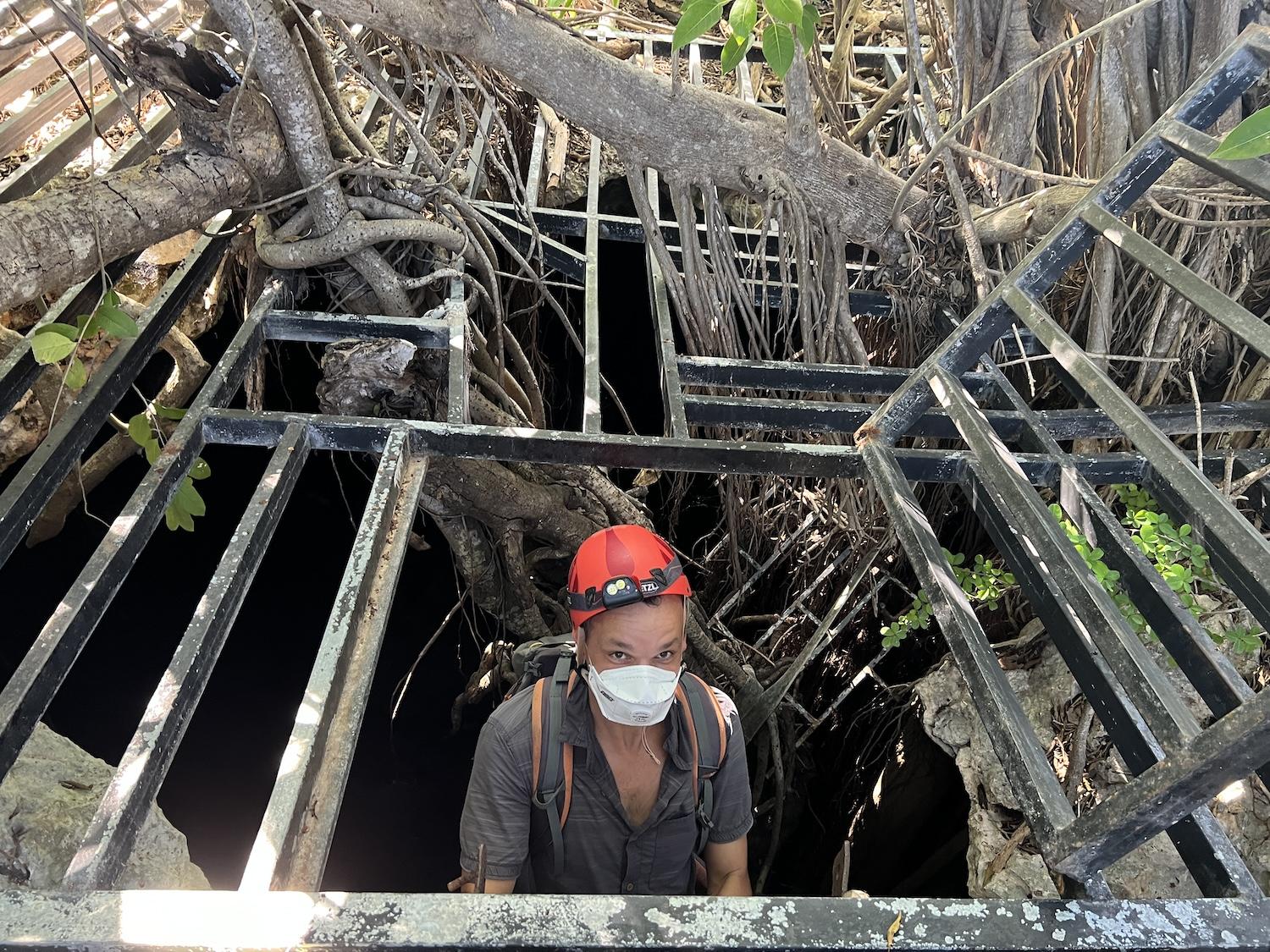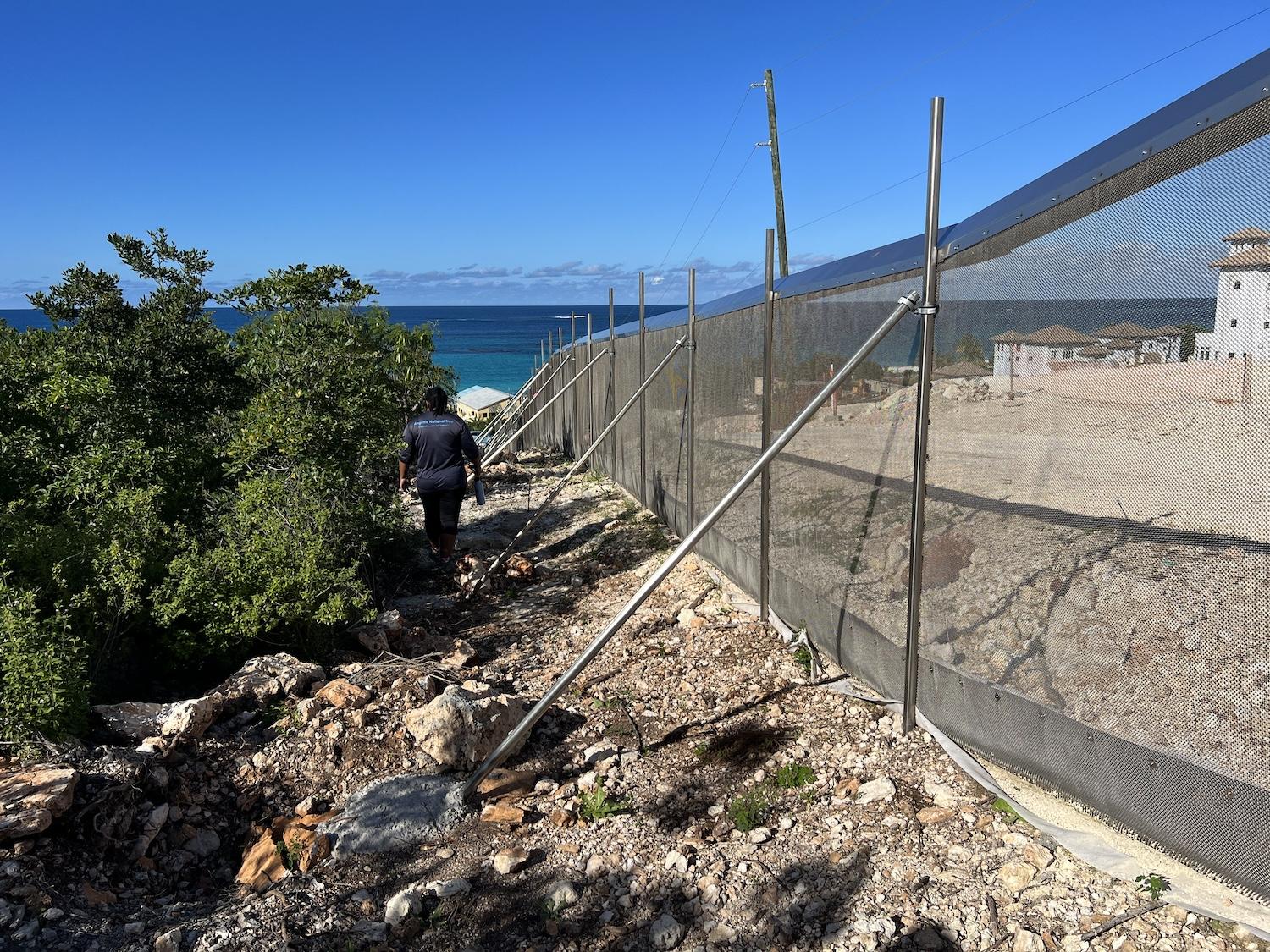
Brown Boobies live on Sombrero Island in Anguilla/Jennifer Bain
To get to tiny Sombrero Island, you must travel 34 miles from Anguilla by sea, dart across the bow of your boat and climb a steel ladder anchored to a limestone cliff. Then, as you regain your bearings and stroll across a barren moonscape plundered by a seabird guano mining operation, the wildlife welcome party makes itself known.
Brown Boobies — with daggerlike bills, yellow feet and chocolate-colored bodies — squawk defiantly while steadfastly guarding the eggs they’re minding in ground nests made of twigs. Same goes for the Masked Boobies, snowy white relatives with black wing and tail feathers that have a distinctive dark mask at the base of their bills and nest right on the ground.
I’m terrified I’ll squash the critically endangered Sombrero ground lizards that race around underfoot, but they are fast and clever enough to evade harm. When I plop down by some ruins to hydrate, the wily creatures dart closer and closer looking for bread crumbs and other treats to offset what must be a monotonous diet that revolves around seabird eggs and sometimes even the birds themselves.

The Sombrero Ground Lizard can only be found on Sombrero Island, an offshore cay that belongs to Anguilla/Jennifer Bain
“Sombrero is a pretty harsh environment,” concedes Farah Mukhida, the executive director of the Anguilla National Trust.
But the Sombrero Island Nature Reserve Marine Park is also Anguilla's first Ramsar site — meaning it’s a wetland site of international importance — and a BirdLife International Important Bird Area. Hardly anybody gets to visit, but those that do are bound by Anguilla’s Marine Parks Act and can’t litter, do research without permission, or collect or introduce any animals. Since boats can’t anchor near the coastline, we’ve been dropped off for a few precious hours of exploration while our captain and crew go fishing.
I’ve tagged along with three locals (a lawyer, a high school biology teacher and a student), two American tourists and a bat expert from Guadaloupe to see the trust’s conservation work in action. Not enough visitors realize that you can sign up for the trust’s $50 nature, heritage and walking tours, or join monthly outings for a $5 donation. The Sombrero trip is a pricey $2,000 for four people if you ask the trust to charter its boat, but free if staff are going anyway and have space.

Anguilla National Trust executive director Farah Mukhida stands on Sombrero Island in front of a nesting Brown Booby/Jennifer Bain
“Ninety-seven per cent of Anguilla is privately owned and we do the hikes, and some of our restoration work, on private land. We try to take people off the beaten path,” explains Mukhida, who is actually a Canadian who studied at Dalhousie University in Nova Scotia and York University in Ontario before landing this dream job 19 years ago.
“It’s nice to see what else you can do beyond the beach.”
Sherry Sanders, a retiree from Virginia who visits the island every fall with her husband Freager, agrees. For years, the couple makes it a priority to connect with the trust. “Anything that’s green and blue — that’s my thing,” Sanders enthuses. “In this case, we’ve got ground lizards and pretty amazing terrain.”

Sherry and Freager Sanders, retirees from Virginia, visit Sombrero Island with the Anguilla National Trust/Jennifer Bain
English-speaking Anguilla — population 15,000 and pronounced ang-GWILL-a — is a British Overseas Territory in the eastern Caribbean that’s known for its white sand, turquoise waters and luxury hotels. With the Malliouhana Resort as my base, I tour the island, take a challenging hike to a sea cave with Quest Experiences, and enjoy a LED kayak at night among sea turtles with Liquid Glow.
But its Anguilla's offshore cays that stand out. The 94-acre Sombrero is a flat, uninhabited and rocky island that earned its name long ago when it was reportedly topped by forest and resembled a hat. Since 1868, it has housed various lighthouses that mark the shipping lane between the Atlantic Ocean and Caribbean Sea known as the Anegada Passage. One, a photogenic beauty, now lies in ruins. The other has been automated since 2001 and we get to climb it — a steep and rather claustrophobia-inducing feat — for panoramic views.
We find a couple crumbling gravestones as we explore, but scant information about the people who were buried here. What has been documented is the phosphate (guano) mining history.

The remains of a lighthouse on Sombrero Island in Anguilla/Jennifer Bain
In the 1800s, Sombrero was mined by the Americans and then the English for seabird guano that was exported as fertilizer. By 1870, the mining operation was yielding 3,000 tons of phosphate a year, but two decades later reserves were exhausted and operations ceased. People colonized remote bird islands around the world for guano, destroying habitat and causing the loss of millions of seabirds.
For every loss there’s a win. In the late 1990s, Andrew Beal’s Texas aerospace company wanted to launch rockets from this seemingly desolate island. Beal even got a lease until conservationists raised a stink and demanded Sombrero’s biodiversity be protected.
So that’s why I get to see those delightful boobies, two of six types of seabirds that now nest on the island. And that’s why this remains the only place in the world where you’ll find the Sombrero lizard (Pholidoscelis corvinus). Deemed critically endangered on the International Union for Conservation of Nature (IUCN) Red List of Threatened Species, the lizard “is at least seasonally food-limited” since there aren’t any amphibians or mammals on Sombrero.

A Masked Booby guards its nest in the rubble on Sombrero Island in Anguilla/Jennifer Bain
When I’m given the okay to feed the lizards bagel crumbs, they’re mildly grateful. After I see them swarming a Brown Booby carcass and realize they’re omnivores, I share some smoked salmon and they quickly carry away the bounty to hideouts under morning glory vines.
Talk turns to the way that the trust eradicated invasive mice here in 2021. There was fear the rodents might impact three lizard species on Sombrero, eating seabirds and boosting competition for invertebrate prey when the seasonal birds were gone.
The trust is slowly bringing back natural vegetation, restoring the barren, moon-like landscape, adding greenery to protect the island’s soils and wildlife from storm surges, and making this special place more resilient to the effects of climate change.

A view of half of Sombrero Island taken from its lighthouse/Jennifer Bain
While we wander Sombrero marveling at our luck to be among the few who visit each year, the Anguilla National Trust team checks on recently planted sea beans and sea grapes and shows off a crater filled with prickly pear cacti.
A solar irrigation system is working, but nothing is growing so Mukhida decides the next step is to release “an onslaught of seeds.” The lizards, she says with delight, “are looking healthy.” A count is planned for next year.
Our outing ends like it began as we climb down that steel ladder and hop back on to the waiting boat.

To get on to and off of Sombrero Island, you have to climb a ladder up a limestone cliff/Jennifer Bain
The trust was founded in 1989 to sustain Anguilla’s natural and cultural heritage. It conducts research and conservation work while raising public awareness about the island’s fragility, complexity and beauty.
At just 14.5 acres, Fountain Cavern National Park may be small but it’s the largest protected area on Anguilla’s mainland. It’s actually where I first meet Mukhida, along with research assistant Devon Carter and terrestrial and wetlands conservation officer Clarissa Lloyd.
The island’s first people — the Taíno (Arawaks) — sought out caves for fresh water and to use as ceremonial sites. This one-acre cave has two main chambers each with a freshwater pool and boasts a stalagmite statue carved into the likeness of the Taíno deity Jocahu (Lord of the Yuca).

The cave at Fountain Cavern National Park in Anguilla is currently closed, but bat expert Baptiste Angin from Guadeloupe enters it while visiting the Anguilla National Trust to do research/Jennifer Bain
Those early inhabitants once climbed down tree roots to get from the entrance in the cave’s ceiling down 40 feet into the cave, but a steel ladder was installed in 1953. I only get to peer longingly into the darkness since the cave is currently closed while, as Mukhida puts it, the trust figures out how to “create a special place where people can come and appreciate how Anguilla was” before settlers arrived.
I do get to see people's names scratched into the leaves of the Pitch Apple (Autograph) tree at the entrance to the cave. And I get a chance to wander around the park learning how, thanks to a three-year grant, a pest-proof, hurricane-resistant fence has just been installed. Invasive species (including rats, mice, green iguanas, goats, monkeys, cats and dogs) are being removed so native species can thrive.
It will be wonderful to watch this national park slowly come to life.

In Anguilla, a new fence encloses Fountain Cavern National Park in a bid to keep invasive species at bay/Jennifer Bain
Mukhida drives me to another place on the island where the trust has been working.
The East End Pond Conservation Area, across from a school, draws birders in search of waterfowl, herons, plovers, sandpipers and stilts, and a few of them are out in the shallow, brackish water. But we're here to see how the trust has converted an infilled portion of the pond from an open field to a forested wild space.

Farah Mukhida, Devon Carter and Clarissa Lloyd from the Anguilla National Trust are shown at the East End Pond Conservation Area/Jennifer Bain
My time with the Anguilla National Trust ends with another boat trip, this time to the Prickly Pear Cays just before I catch a flight home.
Unlike Sombrero Island, which is a daunting 90 minutes away from the mainland, Prickly Pear East is only about 20 minutes away and popular with daytrippers.
It’s also privately owned, with a restaurant and snorkeling, but surrounded by a marine park. Most people don't realize that the trust has quietly eradicated invasive rats and reintroduced native Lesser Antillean Iguanas here to protect the species from extinction on the mainland mainly due to invasive green iguanas.

On an educational outing to Prickly Pear East in Anguilla, the Anguilla National Trust takes stock of conservation efforts/Jennifer Bain
The island, which is mostly dense scrub once you get beyond the glorious beach, is another Important Bird Area and the seasonal home of Bridal Terns, Least Terns, Brown Boobies, Red-billed Tropicbirds and Laughing Gulls. When the birds are nesting, signs politely ask people to give them space.
As we stroll down the beach, we learn that unusual markings on the sand are from a hawksbill turtle. We photograph colorful sea sponges, and spot Brown Boobies in the distance, but we've been spoiled by getting so close to them on Sombrero so they are less of a thrill than they should be. Mukhida opens a couple of rodent bait stations to show how soldier crabs can feast on the blue blocks of poison but not be harmed since it only affects mammals.
She helps me identify all kinds of greenery — seaside oxeye, buttonwood, rosemary and pondweed. But, try as we might, we can’t find the Lesser Antillean Iguanas, which are much bigger than those lizards on Sombrero but elusive and skittish. The hope had been to find one, photograph its face and use artifical intelligence to help identify it as part of population surveys.

Inside a roden bait station on Prickly Pear East, one of Anguilla's offshore cays, soldier crabs gobble up a poison that is harmless to them but lethal to mammals/Jennifer Bain
Still, everyone remains upbeat because it's a gorgeous day and we slip in and out of Prickly Pear before the sunbathers and snorkelers arrive.
“It’s so enjoyable and so peaceful,” says a grateful Sanders, back for another outing with the trust after that memorable trip to Sombrero.
“I live where you vacation — thank god,” teases Farrah Banks, a nature-loving actor and broadcaster from Anguilla, before breaking into the theme song to Gilligan's Island. We remember how much the castaways on that 1960's American sitcom loved their deserted island, before we reluctantly prepare to leave. It's no Brown Booby, but a bold and vocal songbird called a Bananaquit, with its sunny yellow breast, sees us off.

The Anguilla National Trust team visits Prickly Pear East, a popular spot for daytrippers in Anguilla/Jennifer Bain





